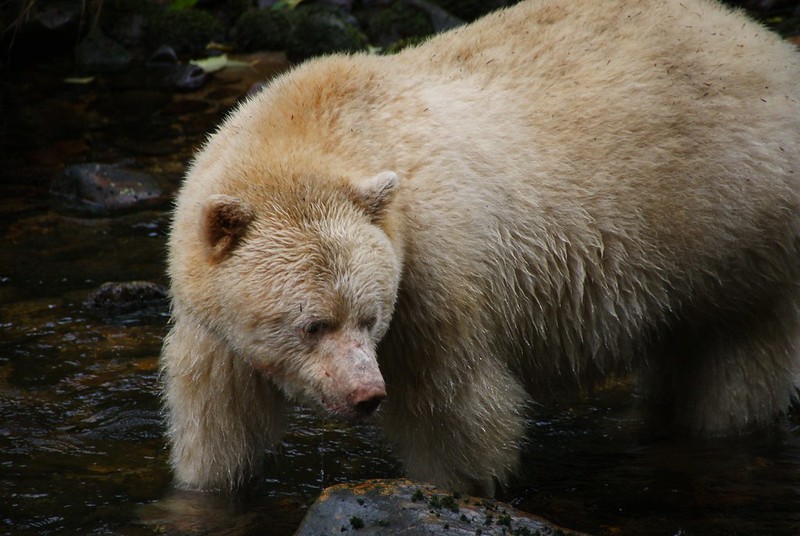The story I will tell you all today inspired me decades ago – and continues to inspire nowadays – in my journey as a climate activist. It’s not only a story about a forest that is crucial for our climate and biodiversity, but also a story about collective action and the power of people winning over greedy corporations. Today, I want to tell you the story about how environmentalists won the battle to protect the Great Bear Rainforest in Canada.
Just shy of the west coast, the boreal forest changes radically: the skinny birch, larch and pine give way to the massive, ancient Douglas Fir, Red Cedar and Sitka Spruce of the Great Bear Rainforest. The air becomes very humid, rain falls constantly and moss drapes the trees in long, bushy clumps. Some of the trees in the Great Bear are 1,500 years old — mere saplings when the Roman Empire was collapsing. The Great Bear, one of the world’s largest temperate rainforests, is home to two extraordinary animal species that are unique in the world.
The only coastal wolves that hunt salmon thrive in the Great Bear. The wolf packs, known as sea wolves, swim up to 10 kilometres among the islands off the coast hunting salmon and are the only population of wolves to rely almost exclusively on the ocean and coastal landscape for food. And that potent symbol of endangered animals, the spirit bear, clings to survival in the area. Spirit bears are a subspecies of black bears that are ghostly white from a genetic anomaly.

The last 200 spirit bears on the planet live in and around the Great Bear, which stretches from the northern tip of Vancouver Island to the Alaskan Panhandle. Photo credit: Maximilian Helm
The ancient forest and the bears thrive in a graceful symbiosis; the bears carpet the forest floor with salmon carcasses, providing vital nutrition to the trees. In return, the tree roots and canopies prevent soil erosion and landslides that would ruin the salmon streams that feed the bears.
The Great Bear Rainforest was formerly known as the “central mid-coast timber supply area.” Environmentalists renamed it after the iconic spirit bear when they began an innovative environmental campaign to persuade the world to stop buying products made from old-growth timber. When European buyers began a boycott of B.C.’s old-growth forest products, gray-suited forestry execs sat down in 2001 with environmentalists for a series of extraordinary meetings called the Joint Solutions Project at the Metropolitan Hotel in Vancouver and negotiated the Standstill Agreement. The environmentalists stopped their market campaigns and the logging companies suspended operations in more than 100 watersheds in the Great Bear region.
In 2006, the stakeholders negotiated an agreement to designate 70 per cent of Great Bear old-growth forest off-limits to logging. The Great Bear Rainforest was formally established in 2006. The tactics in the Great Bear were pioneered by environmentalists on Vancouver Island in the early 1980s prompted by a rising tide of public concern about industrial logging in Clayoquot Sound on the west coast of Vancouver Island. The culmination came in the huge protests, logging road blockades and mass arrests of the 1993 “War in the Woods.” Those protests, the largest act of civil disobedience in Canadian history, sparked a new form of environmental campaigning that reverberated around the globe and drew the Australian rock group Midnight Oil to play a concert at the protesters’ camp.
On the first day of February 2006, a landmark agreement that has been called “one of the most visionary forest conservation plans on Earth” was inked by First Nations elders, the provincial government and environmentalists. Eighty five percent of the Great Bear Rainforest, at 3.1 million hectares, an area roughly twice the size of Vancouver Island, is permanently off limits to logging. The other 15 per cent, about 500,000 hectares, will be available for forestry but governed by the “most stringent” standards in North America, according to environmental groups who were involved in the negotiations. Those standards require the forestry companies to protect waterways, endangered species and respect First Nations cultural values. The deal, known as the Great Bear Rainforest Agreements, also strengthens First Nations oversight of their land and will end the commercial grizzly bear hunt in the region.
Some forestry companies, however, remained impervious to the spirit of reconciliation between stakeholders in the region. In spring 2013, residents of Sonora Island in the Great Bear found out that TimberWest Corp., which has long been known as the conservation laggard among the major loggers in the region, was preparing to legally clear cut some of the last old-growth stands on the island. The movement to protect the Great Bear Rainforest keeps vigilant and active, even decades after the efforts to protect this nature sanctuary started — and I keep supporting them, and being inspired by them every day.